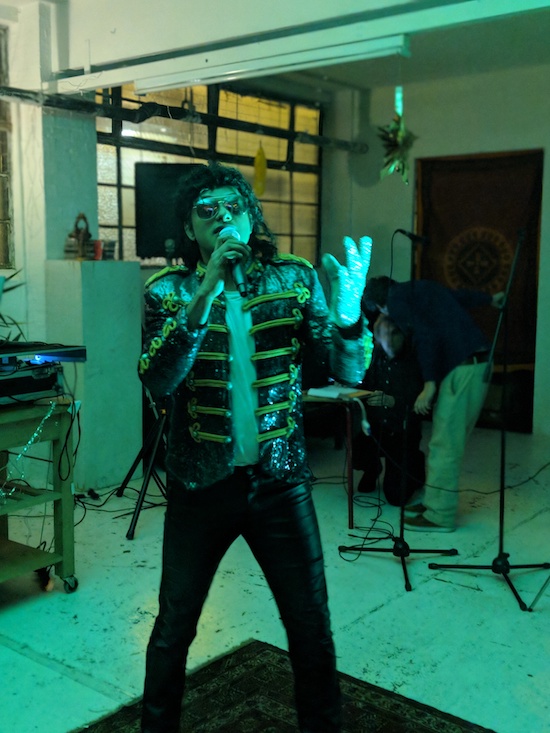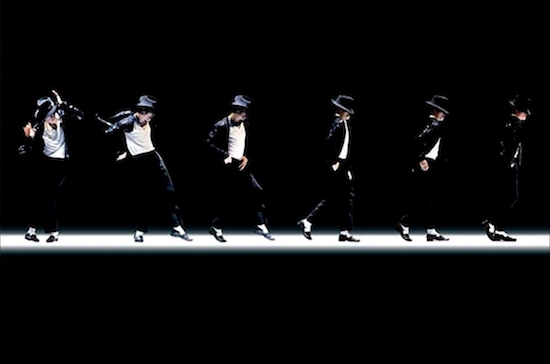On 25th March 1983, Michael Jackson wowed the crowd at Motown’s 25 Year Anniversary concert with a rendition of his number one hit song ‘Billie Jean’ which sent cultural shockwaves across America, and then the world. It was the beginning of Jackson’s ascent to unmatchable superstardom. Last weekend, I attended a fundraising party for a film documenting the lives of Michael Jackson impersonators. There were quite a few Michael Jacksons there, dancing and singing classic MJ hits as if they were the man himself. I played pool with one of them, and had beers with another, which was an odd experience. The Jacksons eyed each other up and surreptitiously competed to be the best MJ in the room. It was hard to not continue to stare at the impressionists’ faces because well, they looked and acted just like Michael Jackson. One even did a perfect rendition, step for step of that Billie Jean performance.
We all know how ‘Billie Jean’ starts, Leon Changler’s 4/4 hi hat and alternate kick and snare drum intro is one of the most recognisable beginnings to a pop song in history. Once the walking bass synth comes in all you picture in your head is Michael, side on, one leg cocked, trilby hatted head angled to the ground, his right arm extended behind him, fingers splayed, and his left hand on his crotch, pelvis thrusting back and forward on each beat. MJ mimes and dances his way through this sublime song with a freedom and spontaneity rarely seen in his later, heavily choreographed routines. Then in the instrumental break, after a couple of ‘woo’s, a spin and a quick pull up of his trouser legs, he busts out the moonwalk live on stage for the first time ever.
Even if the above is the first time you’ve seen that infamous first performance, you’ll no doubt have seen it re-enacted by street entertainers and impersonators, on talent shows, at weddings, at school discos, on the Fresh Prince of Bel Air.
The moonwalk is synonymous with Michael Jackson. His autobiography is called Moonwalker, as is the feature film he stars in. But as many may not know, he did not invent the move. Commonly called the ‘backslide’, a form of the moonwalk has existed since Bill Bailey in 1955 and then James Brown, on into performances on Soul Train and even Jeffrey Daniels on Top Of The Pops performing Shalamar’s ‘Night To Remember’ long before ‘Bille Jean ‘was released. Like many dance moves there isn’t a definitive ‘inventor’, however Jeffrey Daniels is often said to be the man who taught it to Jackson. But what was it about Michael that took this particular move stratospheric?
Was it the sheer weight of his fame? Was it Billie Jean itself? Or was it that he was, in the words of Savion Glover in this excellent video on the performance, on one hand showing something new to mainstream America and on the other, giving a nod to the streets? According to choreographer James Berkery the moonwalk is a total exception: "Is there a more iconic dance move? I really don’t think so. There are many dances moves and choreography that have achieved global recognition like Elvis Presley’s movement in ‘Jailhouse Rock’ or Chubby Checker’s ‘Twist’ but Michael Jackson’s moonwalk remains unparalleled in terms of its association and outreach to not just a huge number of fans but all different types of age, nationalities and ethnicities."
Perhaps this is the key. Jackson was the most successful African American pop star ever, but by the 90s his appearance was almost poly-racial. He was undoubtedly a black man (and proud of it), but his vitiligo had got bad enough that he either used make up to even it out to a kind of whiteness, or allegedly skin bleached. Whilst his aesthetic changes and cosmetic surgery are marred in controversy, it seems to have given anyone permission to be able to capture a bit of MJ in themselves – unless you are Joseph Fiennes. There are several eras of Jackson that people can be, tracked to each album from Off The Wall to HIStory. There was a perceived universality to Jackson that is perhaps unparalleled elsewhere. This is not without its problems, of course, but Jackson was a complex, problematic character, his later years dogged by allegations of child abuse and eccentric behaviour in public.
At the fundraising party for the film Moonwalkers, I spoke to two MJ impersonators. Fabio, a 24-year-old white man from Porto, became an MJ impersonator because people said he looked like Michael. As a kid he was called ‘Little Michael’ and he is uncannily similar to the post-Dangerous version. Fabio told me he has always looked like the late 90s version of Jackson and he considers his looks to be "a gift". He also says has had no plastic surgery. When he dances Fabio says he feels like "Michael is on my shoulder telling me what to do". He studies videos of Jackson rehearsing rather than the finished product because these are "the real performances". Fabio is fragile and shy, much like the version of Jackson he looks like. He appears to genuinely believe he is continuing Jackson’s legacy after his death.

The author with impersonator
<a href="https://www.heart-events.co.uk/portfolio-item/michael-jackson-tribute-by-jay-styles/" target=“out">Jay Styles, who is of south Asian heritage, dresses and performs closer to Bad era Jackson. He works full time as a Jackson impersonator doing over 10 gigs a month and will be doing a theatre tour of Scotland this summer. Jay says that because of his changing image over the years Michael Jackson "can represent everyone". When Jay dances he says he goes through the "same emotions that MJ does". Jay is less sincere about channeling Jackson. He says he feels like he has "metamorphosed" into him, but that "you’re never going to be MJ, you can imitate, but you have to be yourself too." When he performs he gives the people what they want and says it is "pure escapism".

What’s fascinating about the documentary Moonwalkers is that the three Jackson impersonators that director Tom Goudsmit follows are all black. Goudsmit, who has been making the film for five years, tells me that it’s far rarer to find a black impersonator than it is white. Yet if you are a white version, there is only so far back in Jackson’s history you can go before blacking up. And no one should be blacking up. The three impersonators in the film, Chavail, Quintin and Malachi represent three different eras of MJ. The film deftly explores the impersonators backgrounds (broken homes, poverty amongst other things) and why they chase the American dream by being someone else. Jackson was, perhaps for a while, the embodiment of the American dream – a vastly talented man who became the most famous person in the world off the back of his talents. Of course, things went downhill and his life ended as tragedy, perhaps ultimately closer to the American nightmare.

At this party of impersonators (not including the ones in the film, who couldn’t fly over from the USA, sadly) it was hard to keep your eyes off the Michaels in the room. When the most famous man on the planet appears to be near you, or playing pool with you, it is a most discombobulating experience. Perhaps that is what these impersonators enjoy, deep down – to be noticed, to be stared at and to feel famous, rather than ‘be’ MJ. It’s an odd world. The one thing I noticed that was consistent however, was that every single person and the party who spoke to the impersonators said, ‘can you do the moonwalk?’
Over the years, Jackson honed and perfected the moonwalk. He added a neck extension and then a stationary shuffle. The way he snapped his heel and locked his knees took what was ostensibly a fun illusion in street dance to something practically anyone who has heard of Jackson has attempted to do in their life at least once. It’s easy to forget that Jackson used to dance with a bit more freedom, a little more boogie when he was with the Jackson 5 and during the Off The Wall period. There was a deliberate change taking place between Off The Wall and Thriller, where Jackson seems to have decided to change his image, and made choreography a central part of his performance. Hollywood choreographer Bob Fosse is often credited as a big influence on Jackson’s signature style, and when you watch this video of Fosse’s turn as a snake in The Little Prince, you can see the origins of MJ’s many iconic freezes, locks and poses.
The moonwalk is the piece de resistance in Jackson’s dance armoury. It’s the first thing you need to perfect if you’re going to try to impersonate him. And if you, like I have, watch him perform it over and over again (this video of MJ moonwalks runs to 13 minutes if you fancy it) you’ll notice that every time he cracks out the ol’ backslide, the crowd ups the scream volume by about 50%. It’s what the people want to see.
"If history is anything to go by," James Berkery tells me, "we have seen dance moves and choreography achieve global recognition like with superstars such as Beyonce with ‘Single Ladies’, Madonna – with ‘Vogue’ or even PSY’s ‘Gangnam Style’. However, I feel that the impact of the moonwalk and what it represents will remain unparalleled as it’s not just a dance move anymore, it represents the history and legacy of Michael Jackson whose work transcended nationality, ethnicity, race and culture. With over 40 years of success with work spanning from the soul music era into age of hip hop, MJ and the moonwalk will be a tough one to compete with."
Now cock that knee, and slide your heel…


